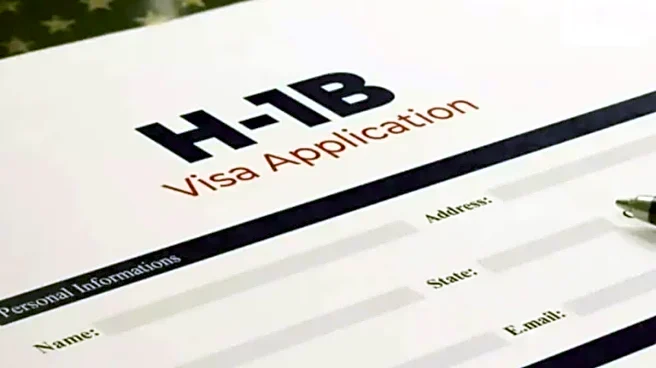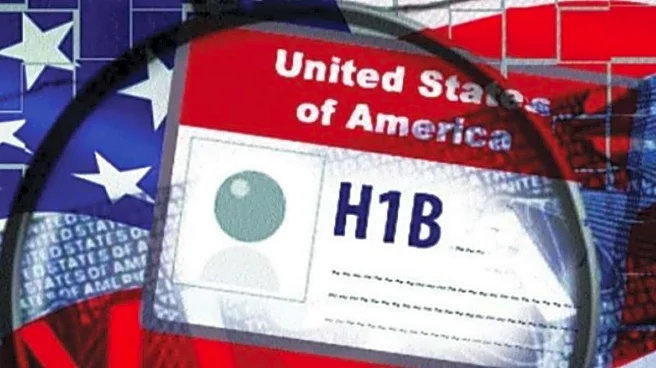On the HIRE Bill, which seeks to discourage outsourcing and impose a steep $100,000 visa fee, Nambiar noted that although the Democrats have blocked it for now, it could resurface and remain a key risk to monitor.
He described the dual threat of tariffs and the HIRE Bill as a “double whammy,” but emphasised that the industry will adopt a wait-and-watch approach given the uncertainty around whether the bill will ever become law.
Nambiar highlighted Global Capability Centres (GCCs) as the brightest growth story for Indian IT. With 1,750 centres employing 1.9 million people and revenues of $65 billion in FY25, he noted that GCCs are moving beyond cost arbitrage to drive innovation and are expected to cross 2,100 by 2030.
Edited excerpts:
Q: It’s been nothing short of a nightmarish weekend for the IT industry and for associations like NASSCOM. While you've issued a revised statement following the White House's clarifications, given the current circumstances, does this make the H-1B route increasingly unviable for Indian IT companies?
We did have a fairly difficult weekend. But, coming back to H-1B over the years, most of the IT companies have reduced their dependency on H-1B visa. Which means that today, we are looking at a much smaller issue compared to what we would have probably looked at maybe four years ago or five years ago. And as you saw, and your channel reported as well, the White House has clarified a lot of issues for the people who are outside of the United States who are H-1B visa holders.
It clarified a lot of other technical issues that we have been grappling with. But the good news is that this comes into effect only from the next year, which is 2026, a new set of visas. There's a little bit of a breather for companies to sort of enhance the skilling options that we have, hire people from the local. In the US itself, there will be a lot of hiring that will now happen. Broadly, while we will have some impact but it wasn't the kind of impact that we thought when the executive order came out first.
Q: Building on your point about the significant reduction in dependency over the past few years, let’s look at last year’s H-1B lottery. How much of the H-1B visa allocation went to Indian IT services companies? While it's well known that US tech firms have been major recipients, could you break down the numbers from the 2025 lottery to show how Indian IT companies fared?
The H-1B programme offers roughly 85,000 visas annually, with 20,000 reserved for a special category. That leaves around 65,000, of which approximately 90% are typically taken up by the tech sector. The Indian share is slightly lower than that, though the majority still comprises Indian professionals.
Looking at the most recent lottery for 2025, Indian-origin companies—many of which may be headquartered elsewhere but are clearly Indian in their operations—received around 15,000 visas. This is significantly lower than in previous years. In fact, there has been a 30% decline over the past five to six years in the number of H-1B applications submitted by these organisations.
While individual company figures are available, it’s important to note that not everyone who is granted an H-1B visa actually travels. Some individuals may have left the organisation in the interim, or the company may no longer require their relocation. There are several variables that affect the final numbers.
That said, the volume we’re dealing with today is much smaller than ever before. With the proposed $100,000 fee now coming into play, we expect these numbers to decline even further. As an industry, we will need to be far more thoughtful and strategic about the volume of applications we submit going forward.
Read Here | Local hiring, near-shoring to help soften H-1B impact on Indian IT firms, says JPMorgan's Ankur Rudra
Q: Talking about applying judiciously, given the fact that you are now going to have to deal with $100,000 price tag for every petition filed. Does this price out the small-cap, mid-cap, IT companies? Does this largely then remain in the preserve in the realm of the four or five big tech Indian IT services companies?
The good news is that most of them have the option to sort of really do local hiring. Some of them, even both the mid-tech companies, mid-tier tech companies, as well as some of the small companies, have begun to sort of do some local hiring as well. H-1B is not the only route that they need to work on. Certainly, we do believe that blocking this route is not a very good option for some of them.
But let's also understand that the H-1B work is a small percentage of the overall US workforce. In most cases, it's a very small percentage of the total workforce that any of these companies have, the mid-tier tech companies, as well as the large tech companies. It's a small number to begin with. There are other options available for people to work on as well, but it is certainly without a question, as you rightly said, especially for some of the smaller organisations, these costs will be a little bit prohibitive.
However, the good news is that initially it was annual and then we were a little concerned about that, but now it is clarified that it is a one-time fee, which means that you are taking that and then proportioning it over six years. The real impact of some of this is a lot smaller than what we thought initially.
Q: On the point that you made that companies are now going to hire locally, as opposed to taking people on H-1B. Now, if you had the ability to hire locally, why would you use the H-1B route, unless there was a significant cost arbitrage involved? What happens now, if you're going to be hiring locally and the cost arbitrage is done away with, the impact on margins as we move forward, we have already seen margins being under pressure. What could this mean now in terms of growth going forward?
Broadly, H-1Bs are not necessarily only for arbitrage alone, because in this arbitrage, certainly in the offshore component of what we do for the services companies, but the on-site movement with the H-1B did not have much of an arbitrage. Of course, they are also paid. If you go back and look at the average wages paid to these workers by the organisation, most of the large organisations, there isn't a big difference in terms of local hiring and this as well. There was, of course, a little bit of a difference.
But the bigger challenge for us would have been the availability of talent, making sure that they are trained well, if somebody is going from a certain project offshore to on-site, to ensure the continuation of what they have learned within their offshore account. There are a lot of issues related to talent mobility, if you may. People who are going there to lead a certain piece of it – all of that was also important from that point of view.
Now, local hiring will certainly have a little impact from a margin point of view, but it is not a huge, huge impact as far as these companies are concerned. I also believe that the $100,000 threshold, which will come into effect from next year onwards, will have a minimal impact on margins. But the question is, instead of saying margin, I would prefer to say cost here. The reason is that some of these costs will actually be passed on to the end consumers or customers of these organisations, which means that there may not be a margin impact at all on these companies. Because if you are able to pass it on as a cost to these companies and then include it in the pricing, the margin remains unaffected.
Q: Any initial feedback coming in from clients and customers? What has this done to confidence? What has this done to sentiment? We saw over the weekend several reports suggesting that there was guidance given by many companies telling people on H-1B visas not to travel if they are outside the US and to return. We also saw that panic play out in terms of ticket prices for certain routes. Does that guidance still hold despite the clarification, and what is the overall mood or sentiment you are picking up from clients and customers at this time?
First of all, that guidance was issued before we had the clarification, which was issued by the White House after about a day or two. All of that, in terms of not travelling, no longer applies, because there is now no restriction on people who already hold H-1B visas travelling. This means that even if you are outside the country, you can still return, and if you are in the country, you can travel abroad, etc.
From our customers and clients, who are global in nature — of course, a significant percentage of our business, around 63%, in the Indian tech industry relies on the US customer base — they have been quiet, I must say. Most of them have certainly quietly supported us. They have been a little reticent to come forward and openly discuss this in the media, but they have been very supportive. I don’t think we have seen any instances where they have had a panic reaction to this, and they understand that had the clarification not come through, it would have caused far more personal difficulties for those who had travelled abroad.
Looking forward, we have another year or so to assess what this really means for all companies. We have spoken to many organisations and are very confident in how we will handle this. At the same time, let us not minimise the impact such orders have on our broader business. So, it’s a balanced approach. I think we understand the impact, but at the same time, we need to focus on what is required at this moment for the industry.
Read Here | H-1B fee hike unlikely to dent Indian IT in a big way, say analysts
Q: The larger messaging and signalling that this move sends out is that it’s no longer just about goods — the battle has moved beyond goods now to services and this perhaps is the first salvo, so to speak. We don’t know what will eventually happen to the HIRE Act, as it is akin to a private member’s bill, so there is a long way to go before it becomes law. But is there concern building within the industry that this is the first salvo on a new front?
There are two issues that you have mentioned here - one is tariffs, and the other one is, of course, the HIRE Act, or HIRE bill. I don't want to call it an Act. I want to call it a HIRE bill, because until it becomes an act, it is still a bill.
On the tariff side, as of today, the tariffs are still on goods, not on services. Most of what is happening is around speculation and most of the speculation is coming from, not from the administration, but from others tweeting or probably related to the administration, in some sense, but so we wouldn't give too much credence to tariffs on services as yet. While we will be prepared, we will make sure that there is enough work which is being done in terms of understanding what we need to do if there are tariffs.
The second element is the HIRE bill and this is, of course, as most of you know, promoted by a senator. The good news is that we already got a block by the Democrats on the bill, which means that it hasn't gone through the process as yet. But that doesn't mean that it will go away anytime soon. You will have to watch carefully as to what it means to us in the longer duration, and we will wait and watch as to what it means to some of us.
But if you, what is really going on is there is there are both ways. At one end, there are jobs in America, a higher visa fee, etc, or the $100,000 that you put on it will make sure that there aren't too many people who are taking those jobs away. And the HIRE Act is sort of aimed at saying that there aren't too many jobs you're going out as well. It is sort of a double whammy in some ways. But we will wait and watch. I mean, at this point in time, we want to be taking a very balanced view on what the HIRE Act is. I doubt whether this will see the light of day, given that it has to go through a lot of hoops, and then 60% approval from the Senate before it becomes an act.
Q: On the tariffs, of course, the matter is pending before the Supreme Court. The Supreme Court in the US is going to take this up. The appeals court has ruled against the imposition of tariffs. Is there any conversation around mounting a legal challenge on the H-1B changes that have been moved?
A: Look that will be the last option anybody want to sort of consider at this point in time. There are many things that we do as an industry, we will, we will be committing to making sure that we do this right, which means that we highlight on the amount of jobs this industry is creating in the United States, the amount of training that this industry is doing. We have trained close to a million people within the ecosystem, within the United States. We are one of the biggest training provider within some of the artificial intelligence and related topics within the United States, in some of the pockets that we have been addressing. We roughly employ about 210,000 people in the United States. So, there's a lot of good things which is happening. We just want to make sure that we are able to consolidate it.
Our narrative is going to be very different and we want to make sure that we, we are truly doing this with a very balanced way. I mean, litigation would probably be the last thing that we want to talk about. Of course, that option is always there. Again, we would not front-end anything like that. But we would take other options to make sure that we are able to do that as well, if it comes through.
Q: You talked about the good stories, and the silver lining, really, for the IT business has been the global capability centres (GCCs) business, which is flourished. We have seen, of course, the significant growth and rise of GCCs operating in India, and many people suggesting, including industry veterans of the IT services sector, that this is in fact, going to move more jobs and more work and more business to GCC so this may not be as negative a hit as is being imagined or expected. What's your take on that?
A: We can always look at it positively, and I think that's the right way to look at some of this. GCC has been a phenomenal story. We have been advocating this for the last many years. It's certainly the brightest star, if you may. Today, as of now, we have 1,750 GCCs in India, growing at a much, much faster clip. The revenues have grown up to $65 billion in FY25. The GCCs together employ about 1.9 million people as of today and we have also said that by 2030 this number is going to be much larger. It's going to be upwards of 2100 or so, which basically means that every, every week or so, we have one or two GCC setting up shop, which means roughly about 90 to 100 in a year is what we are saying. This growth will continue, there is no question.
I do believe that if we stay focused on true value addition, as you know, GCCs have moved away from truly focusing only on cost arbitrage now it's all about innovation. It's all about how much revenue impact that they are having on the parent companies, as opposed to only saving costs. So, I think we have come a long way in the GCC journey, and I am very, very positive that this will continue to be the case as we move forward.
Q: That brings me then to the final question, which is something that's been up for debate now for very long, whether Indian IT services, finds itself at an inflection point yet again, and whether this is, in fact, an existential crisis for the current business model. The criticism has been that Indian it hasn't done enough to move up the value chain, to do enough on innovation, and perhaps has spent too much of its capital on buybacks and such like. How do you respond to that criticism and do you believe that this is, in fact, an existential moment for India's IT services sector, yet again?
A: I don't think there's an existential crisis at all. By far this industry, has been very resilient to several of these interventions that we have seen in the past. The enterprise tech spending will continue to be resilient. With certainly, budgets increasingly directed towards AI to unlock value creation and you also find that there's a lot more spend now on the newer growth areas, which means that we are pivoting into something very new.
Remember, when we are doing all of this, there has also been this whole change in technology with things moving into generative, AI, agentic AI etc. there is a lot that we do when looking at future of technology. We have sent out a report - I am not sure how many of you have seen that together with McKinsey, in the next three to five years, agentic AI alone could unlock about $300 to $500 billion in totally new market opportunity. So are we ready for making sure that we are capturing some of those market opportunities. It is important for us to make sure that we are doing all of that so a lot happening.
I don't think it is fair to say that this industry is sort of going through its end phase, far from it. I am very bullish about what this industry can offer in the in the days to come. So, I am looking forward to making sure that we tied over this. Of course, we'll go through a little bit of a pain in the short term. But let's not forget that if you look at a long-term view, not even that long term, look at three to five years down the line, you are going to find that everything is going to be tech led, tech infused, which means that there is need for technology, the need for technologists, including, artificial AI and agentic AI, etc. ability for us to make that pivot and ensure that we are building sustainable systems is going to be the need of the hour. There is no question that the Indian tech industry will come through as a shining star in all of this
Q: In the short term, can you quantify the impact, the hit on account of the H-1B change, as well as perhaps just holding back as far as orders are concerned, if at all that were to happen? Is there any kind of an estimate that's been put together?
A: As NASSCOM, we tend not to give any market estimates. The companies have been working on this. As I mentioned before, one good news is that there is no near-term impact at all. We are not worried about what happens in the next, three or four quarters. We do think that in 2026 if this $100,000 stay, there will be an impact from a cost point of view, again, because of the fact that even if you are going to be applying for smaller number of visas, this $100,000 per visa will be a sort of a number. But remember this, there are large organisations - when you take a number like this spread across six years then the impact on a yearly basis is going to be very low. There will be a marginal impact on the on the on the cost.
And again, as I mentioned before, that can be translated into pricing changes and could be passed on to the clients or that's something which the companies could take it on their margin. So that's something which the individual companies will make those calls. We haven't seen any slowdown or anything on the client side because of this at this point in time. I don't believe that in the short term there will be any significant impact at this point in time.

/images/ppid_59c68470-image-175847752488263793.webp)
/images/ppid_59c68470-image-175849504937231852.webp)
/images/ppid_a911dc6a-image-175854383847820718.webp)



/images/ppid_59c68470-image-175844253458573866.webp)




